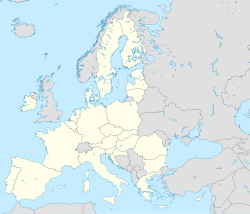Kiruna
| Kiruna - Giron | |
|---|---|

Clockwise from top: Kiruna skyline by night, Kiruna Church, the Icehotel in Jukkasjärvi, rocket launch at Esrange, bell tower at Kiruna Church.
|
|
| Coordinates: 67°51′N 020°13′E / 67.850°N 20.217°ECoordinates: 67°51′N 020°13′E / 67.850°N 20.217°E | |
| Country | Sweden |
| Province | Lapland |
| County | Norrbotten County |
| Municipality | Kiruna Municipality |
| Charter | 1948 |
| Area | |
| • Total | 16.53 km2 (6.38 sq mi) |
| Population (31 December 2010) | |
| • Total | 18,148 |
| • Density | 1,098/km2 (2,840/sq mi) |
| Time zone | CET (UTC+1) |
| • Summer (DST) | CEST (UTC+2) |
| Website | kiruna.se |
Kiruna (Northern Sami: Giron, Finnish: Kiiruna) is the northernmost town in Sweden, situated in the province of Lapland. It had 18,148 inhabitants in 2010 and is the seat of Kiruna Municipality (population: 23,099 in 2008) in Norrbotten County.
Esrange Space Center was established in Kiruna in the 1960s. Also in Kiruna are the Institute of Space Physics and the Department of Space Science belonging to Luleå University of Technology.
Archeological findings have shown that the region around Kiruna has been inhabited for at least 6,000 years.
Centuries before Kiruna was founded in 1900, the presence of iron ore at Kiirunavaara and Luossavaara had been known by the local Sami population. In 1696, Samuel Mört, a bookkeeper of the Kengis works, wrote on the presence of iron in the two hills. The Swedish senior enforcement officer and cartographer and mapper Anders Hackzell mapped the Kiruna area in 1736 and gave the mountains of the area their Swedish language names Fredriks berg (original Finnish name still in use as well: Kiirunavaara) and Berget Ulrika Eleonora (original Finnish name still in use as well: Luossavaara), after the King of Sweden Fredrik I and his wife Ulrika Eleonora.
Despite the findings of large amounts of ore, no mining was initiated because of the remote location and the harsh climate. Some ore was extracted in the 19th century. It was extracted in summer and transported in winter, using sleds drawn by reindeer and horses. However, the costs were high and the quality of the phosphorus ore poor, until, in 1878, the Gilchrist-Thomas process, invented by Sidney Gilchrist Thomas and Percy Gilchrist, allowed for the separation of phosphorus from the ore.
...
Wikipedia



